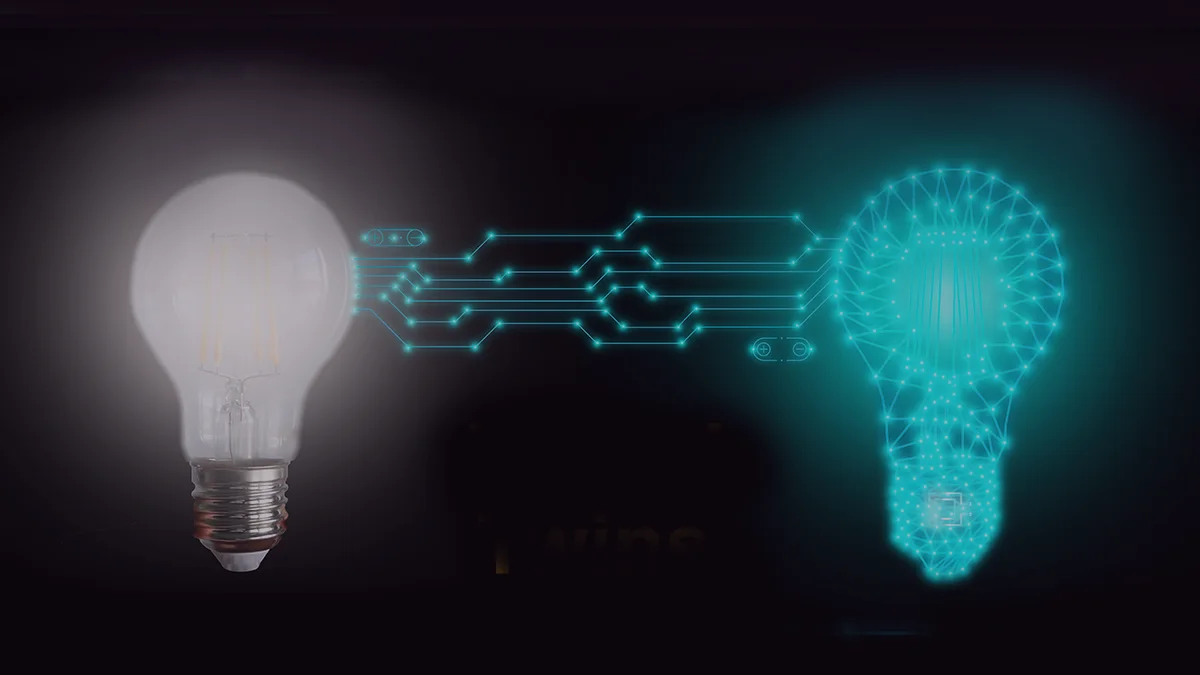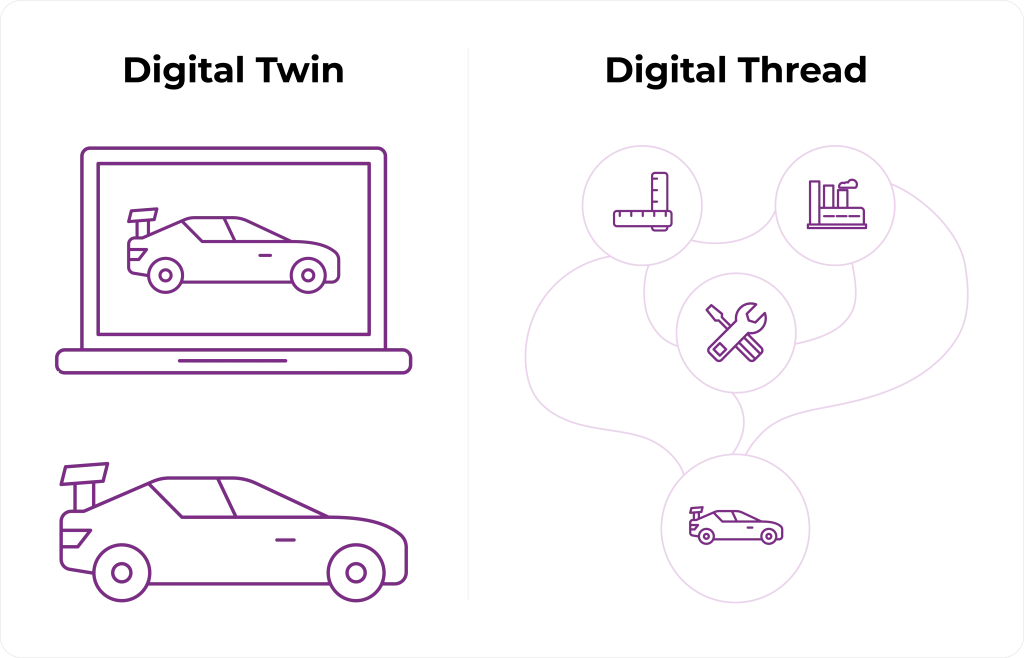Digital Thread and Digital Twin – Key Differences and Applications

In the era of rapid industrial digitalization, ideas such as digital twin and digital thread are gaining importance as integral elements of digital transformation. Although these terms are often used interchangeably, they refer to distinct yet interconnected concepts. Understanding their essence and mutual relationships helps organizations make informed decisions about investing in innovation.
Key definitions
Industrial Digital Twin and its applications
A digital twin is a virtual replica of a physical object, process, or system that mirrors its behavior and properties in real time using sensor data, simulation models, and analytical algorithms.
Imagine a digital “double” of a machine, building, vehicle, or even an entire factory, existing on a computer screen as a three-dimensional model and “living” thanks to its connection with the real object. When something moves, heats up, wears out, or stops in the real machine, its digital twin instantly reflects this. This enables safe testing of changes, failure prediction, and optimization of the actual object’s operation without physical intervention.
“A digital twin is a virtual representation of a physical object or system across its lifecycle. It uses real-time data and other sources to enable learning, reasoning, and dynamically recalibrating for improved decision making.”
A digital twin can represent a process, component, or an entire factory, each providing specific operational benefits. The digital twin model allows for the simulation of physical object behaviors under various working conditions.
- A component’s digital twin can help predict the wear of key mechanical elements, making it especially useful for maintenance optimization and service planning.
- Digital twins of infrastructure introduce a new quality in resource management: they enable scenario simulations, real-time monitoring, and integration with ERP and MES systems. As a result, digital twins are revolutionizing the way companies plan development and respond to unforeseen events.
Digital Thread
A digital thread is a continuous flow of data and information about a product, system, or process throughout its entire lifecycle-from design, through production, to operation and servicing.
Imagine a digital “thread” connecting all stages of a product’s life-from the first sketch to disposal. Data from each step-engineering design, test results, production data, real-time sensor measurements-are “strung” along this thread. This ensures every decision is made with full insight into the history and context of a given component or device.
The digital thread provides complete transparency and traceability of data powering solutions such as digital twins, PLM, MES, ERP, and IoT systems.
“A digital thread enables the capture and connection of information to deliver improved performance and value.”
It is a way of organizing and managing information that eliminates data silos. Every stage-from design requirements to operational data-is logically and systematically linked. The digital thread allows full traceability: who, when, and why a change was made to a product. This facilitates better quality management, regulatory compliance, and accelerates product development by providing easy access to historical knowledge.
It’s important to note the distinction: the digital thread vs. digital twin comparison is one of data architecture (thread) versus dynamic simulation (twin).
Tools such as PTC Windchill enable the creation of a coherent digital thread, connecting engineering, production, and service data. With full integration with CAD (e.g., Creo) and PLM systems, companies can effectively manage the entire product lifecycle-from design to operation.
Digital Manufacturing
As a related concept, Digital Manufacturing integrates data, digital technologies, and manufacturing processes to create flexible, optimized, and intelligent manufacturing environments. It is a natural extension of the digital twin and digital thread concepts, combining them in practical applications on the shop floor. Creating digital twins for a manufacturing company begins with preparing a virtual replica of objects based on product engineering and production data.
Solutions like ThingWorx support digital manufacturing by enabling real-time integration of machines, sensors, and IT/OT systems. Combined with Creo and Windchill, they form a complete ecosystem supporting digital transformation in the spirit of Industry 4.0. ThingWorx features a built-in digital twin framework that allows for real-time model versioning and updates, as well as testing changes without impacting actual processes.

Key differences between the concepts – Digital Thread and Digital Twin
In the era of digital transformation, terms such as Digital Twin and Digital Thread increasingly appear in the context of data management, process optimization, and the development of smart products. While closely related, they serve different functions and are based on different principles.
- The digital twin focuses on a specific, current representation of reality-a kind of “digital mirror” of a physical object or process, reflecting its behavior in real time. With dynamic, operational data, it enables not only system monitoring but also problem diagnosis, simulations, future scenario prediction, and remote management. It operates in the here and now-its role is immediate response and ongoing optimization.
- The digital thread, on the other hand, offers a much broader perspective. Instead of focusing on a single element, it encompasses the entire lifecycle of a product or system-from design and production, through operation, to end-of-life. It is the history, memory, and data architecture that ensures continuity and consistency of information. The digital thread connects engineering and operational data-both current and historical-creating the context necessary for audits, lifecycle analyses, automated decision-making, and traceability. This enables better decisions based on comprehensive knowledge from the past, present, and potentially the future.

In summary:
A digital twin is an operational tool that works “here and now,” while a digital thread is an informational structure stretched over time, representing the digital history and logic of product development. Together, they form the foundation for an intelligent, integrated approach to information management in modern organizations.
Digital Twins – from concept to practice
Having covered the theory and basic concepts, let’s move on to more practical information. The digital twin concept evolved from the need to better understand and optimize physical objects and processes. It’s not just about a visual model, but above all a comprehensive, dynamic representation “brought to life” by data collected from sensors, control, and usage systems in real time. Thanks to digital twins, current data becomes the basis for decisions that previously required physical testing.
In practice, creating digital twins begins at the design stage. A digital twin model integrated with CAD software allows analysis of how components will behave in reality before they are manufactured.
Examples of Digital Twin applications
Aerospace and Defense:
- Simulation of aircraft engines and their behavior under various conditions.
- Management of technical documentation and component compliance with regulations.
Industrial Manufacturing:
- Use of twins to test process changes without interrupting production.
- Integrated digital thread connecting designers, engineers, and operators.
Medical Sector:
- Real-time monitoring of medical devices and failure prediction.
- Management of product data from R&D to the patient.
Automotive:
- Testing and calibration of ADAS (Advanced Driver Assistance Systems).
- Managing software and component versions throughout the vehicle lifecycle, enabled by solutions like PTC Windchill MPMLink, ensuring data consistency and synchronization between engineering and production departments.
Impact of Digital Twins on lifecycle management
Since digital twins collect data throughout the product lifecycle, detailed data analysis and predictive maintenance become possible, fitting perfectly into predictive maintenance strategies.
Digital twins also enable virtual modeling of the real working environment of machines, increasing forecast accuracy and operational efficiency. Implementing digital twins supports product lifecycle management and enables faster responses to market needs.
Digital Twin Framework and Industry Standards
Technological development requires increasingly robust security and standardization – don’t forget that.
A digital twin framework enables the creation of scalable, easily integrated solutions that can be used locally or in the cloud and includes:
- Physical object modeling – representation of geometry, operational parameters, behavior, and dependencies.
- Real-time data collection – integration with IoT sensors, SCADA, ERP, MES, etc.
- Data integration and communication layer – APIs, communication protocols (e.g., MQTT, OPC-UA), middleware.
- Analytical and simulation systems – predictive models, ML/AI, root cause analysis, what-if simulations.
- Visualization and interaction layer – dashboards, VR/AR, 3D model viewers, operational alerts.
- Lifecycle management – updating the model alongside changes in the real system (design-to-disposal).
- Security and compliance – access management, data integrity, compliance with ISO 23247 and others.
ISO 23247 Standard – defines the digital twin framework for manufacturing
The ISO 23247 series, published in 2021, provides guidelines for implementing digital twins in manufacturing environments. The standard covers four main areas:
- Observable Manufacturing Elements (OME): definition and classification of elements that can be represented by digital twins (machines, processes, personnel, or materials).
- System architecture: description of the digital twin system structure, including components, interfaces, and data flows.
- IoT integration: guidelines for connecting digital twins with Internet of Things systems for real-time data collection and analysis.
- Lifecycle management: procedures for creating, updating, and deleting digital twins in the context of the entire product or process lifecycle.
You can find more about ISO 23247 HERE
It’s also worth noting the Digital Twin Consortium, a global organization developing frameworks, reference models, and best practices for digital twins, focusing on interoperability and standardization across industries.
Benefits of Implementation

- Higher Operational Efficiency:
Real-time data integration enables automatic detection of inefficiencies, trend analysis, and faster response to changes. Digital twins allow simulation of scenarios without production downtime, while the digital thread provides context and continuity-reducing response times and increasing decision accuracy. - Better Product Quality:
Ongoing monitoring of production parameters allows immediate detection of deviations from standards. Combined with the digital thread, it is possible to trace the source of a problem back to the design phase or a specific material batch. The result: fewer errors, fewer complaints, higher customer satisfaction. - Lower Costs:
Digital twins support predictive maintenance-service is performed exactly when needed instead of on a fixed schedule. The digital thread streamlines information flow, eliminating redundancy and reducing the time needed for design and implementation of changes. Together, these technologies significantly lower operational costs and accelerate time-to-market. - Increased Innovation:
Simulations, rapid testing, and the ability to compare alternative solutions in a digital environment encourage experimentation. The digital twin allows testing new concepts without risk, while the digital thread provides access to historical data that can inspire new approaches. This fosters continuous improvement and innovation. - Improved Knowledge and Communication Management:
The digital thread eliminates knowledge fragmentation-design, production, and operational data are available to all stakeholders, regardless of department or location. This facilitates collaboration, shortens information retrieval times, and enables decisions based on full context.
Digital twins enable continuous process monitoring, faster detection of potential issues, and simulation of scenarios previously impossible to test without risk. In many cases, they eliminate the need for physical prototypes, significantly reducing costs. At the same time, data analysis from digital twins allows for ongoing improvement of production processes. Digital twins are revolutionizing operational and strategic decision-making.

Challenges and the Future
- Integration with Existing Systems:
Many companies use extensive, often outdated IT and OT systems. Consistent integration requires time, resources, and careful planning. - Data Management:
Digital twins and threads generate vast amounts of data. Their quality, consistency, and usefulness directly affect the effectiveness of analyses. - Security and Privacy:
Processing sensitive data, especially in sectors like energy, defense, or healthcare, requires advanced safeguards and regulatory compliance (e.g., GDPR). - Costs and Competencies:
Implementation requires not only technological investment but also organizational culture change and employee training.
The development of digital twin and digital thread technologies will be increasingly tied to practical business needs. Key directions include:
- Integration with AI – automated decision-making, failure prediction, and process optimization through machine learning.
- Modeling entire systems – moving from individual machines to digital twins of production lines, factories, or supply chains.
- Standardization – emphasis on open formats and interoperability between systems from different vendors.
- Scalability and personalization – solutions tailored to specific needs, deployable both locally and globally.
- Wider access to tools – technologies are becoming easier to use and accessible to more users within organizations.
In the coming years, expect even greater integration of tools such as PTC Creo, Windchill, and ThingWorx with AI technologies, enabling predictive maintenance, automated recommendations, and dynamic real-time simulations of digital twins.

Summary
Digital twin and digital thread are not fleeting trends but the foundation of digital transformation. The former provides a current, dynamic insight into the operation of objects and processes, while the latter ensures continuity and consistency of data throughout the product lifecycle. Together, they form a powerful tool for increasing efficiency, quality, and innovation.
While their implementation comes with challenges, the benefits-both short- and long-term-are substantial. Companies investing in these technologies today gain a competitive edge and a solid foundation for further growth in the era of Industry 4.0 and the upcoming Industry 5.0.
You may also want to read our other articles:
